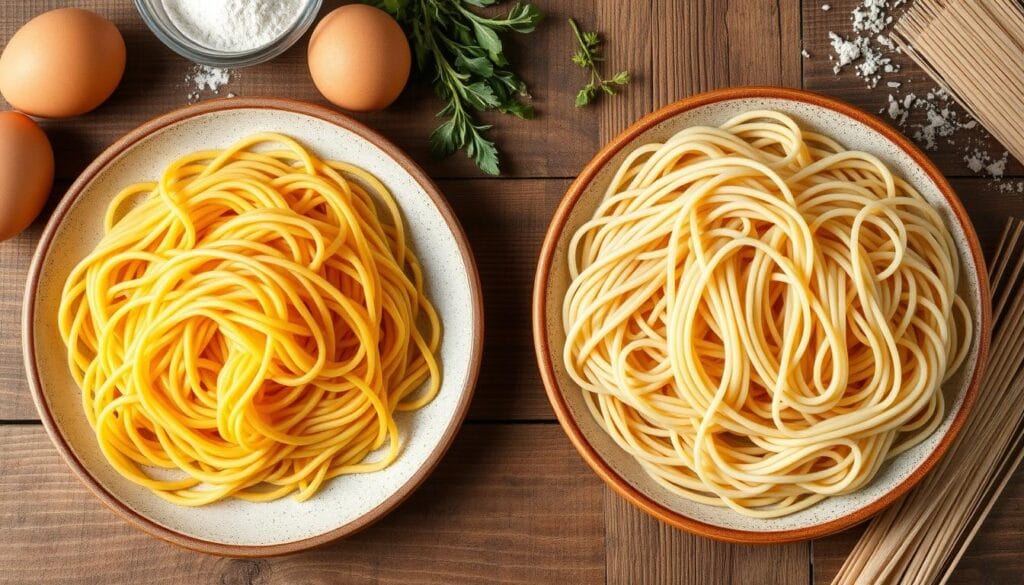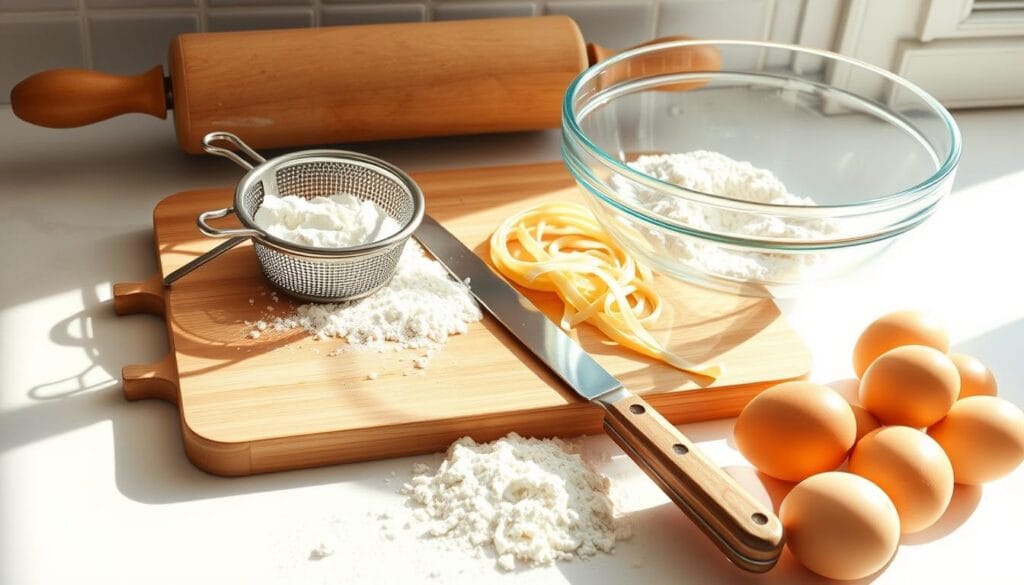I remember the day I found out I had a wheat allergy. It felt like a big setback, making me miss my favorite pasta dishes. But it also started my journey into gluten-free cooking. Now, I’m excited to share a simple recipe for gluten-free egg noodles that will change how you cook.
Making gluten-free pasta is not just about following a diet. It’s a creative process. Whether you need to avoid wheat or just want to try something new, these noodles will be your secret ingredient in the kitchen.
This guide will show you how to make gluten-free pasta that’s just as good as the traditional kind. You’ll learn to turn basic ingredients into delicious noodles that are healthy and flavorful.
Table of contents
- What Are Gluten Free Egg Noodles?
- Why Choose Gluten Free Egg Noodles?
- Essential Tools for Making Egg Noodles
- Ingredients You Need for Gluten Free Egg Noodles
- Step-by-Step Guide to Making Egg Noodles
- Different Ways to Cook Gluten Free Egg Noodles
- Flavoring and Seasoning Your Noodles
- Storing Leftover Noodles
- Creative Recipes Featuring Gluten Free Egg Noodles
- Common Mistakes to Avoid
What Are Gluten Free Egg Noodles?
Exploring the world of alternative noodles opens up exciting culinary possibilities. Gluten free egg noodles are a delicious solution for those with dietary restrictions or looking to try something new.
These innovative noodles are made without traditional wheat flour. They use ingredients like rice, corn, or almond flour with eggs. This creates a texture similar to classic pasta.
Definition and Key Ingredients
Vegan egg noodles have unique ingredient combinations for nutrition and flavor. Common ingredients include:
- Rice flour
- Corn flour
- Almond flour
- Potato starch
- Tapioca flour
Nutritional Highlights
Understanding the nutritional profile of these noodles helps in making dietary choices. A typical serving of homemade gluten-free egg noodles offers impressive nutritional benefits.
| Nutrient | Amount per Serving |
|---|---|
| Calories | 507 kcal |
| Carbohydrates | 61g |
| Protein | 20g |
| Fat | 22g |
| Fiber | 10g |
When making your own grain-free noodles, you can adjust ingredients to fit your dietary needs and taste.
Why Choose Gluten Free Egg Noodles?
Finding tasty food that fits your diet can be hard. Gluten free egg noodles are a great choice for those with gluten intolerance. They taste great and are good for you.
Health Reasons for Going Gluten Free
Gluten free egg noodles can make eating better for your health. They’re perfect for people with celiac disease or gluten sensitivity. Now, you can enjoy pasta without worrying about how it makes you feel.
- Reduces digestive discomfort
- Supports better nutrient absorption
- Helps manage autoimmune responses
Flavor and Texture Comparisons
Today’s gluten free egg noodles are a game changer. They’re not all gluten free, but some are just like regular noodles. They taste and feel the same.
| Noodle Type | Protein (g) | Fiber (g) | Calories |
|---|---|---|---|
| Chickpea Pasta | 14 | 8 | 190 |
| Red Lentil Noodles | 15 | 3 | 180 |
| Gluten Free Egg Noodles | 8 | 2 | 140 |
Knowing what type of noodles are gluten-free helps you make better choices. Whether you’re watching your health or just trying new foods, gluten free egg noodles are a great pick.

Essential Tools for Making Egg Noodles
To make gluten free noodles at home, you need some basic kitchen tools. Your journey to making tasty egg noodles begins with knowing the right tools. These tools will change your cooking experience.

When making gluten free egg noodles, you’ll need a few key tools. This makes cooking smooth and fun. Are ramen egg noodles gluten-free? Traditional ramen noodles have gluten, but you can make a gluten free version with the right tools.
Pasta Maker vs. Rolling Pin
Choosing the right tool to flatten dough affects your noodles’ texture. Here’s a comparison to help you decide:
| Tool | Pros | Cons |
|---|---|---|
| Pasta Maker | Consistent thickness | More expensive |
| Rolling Pin | Affordable, versatile | Requires more skill |
Essential Cutting Tools
Are egg noodles IBS friendly? While it varies, the right cutting tools help make uniform noodles. These are easier to digest.
- Sharp chef’s knife
- Pizza cutter
- Large cutting board
Pro tip: Use a sharp knife for gluten free noodles. This ensures clean, even cuts. It prevents uneven cooking and keeps the texture consistent.
You don’t need expensive gadgets in your kitchen. With a few basic tools, you can make delicious gluten free noodles. They can even rival store-bought ones.
Ingredients You Need for Gluten Free Egg Noodles
Making gluten-free egg noodles is all about the right ingredients. Knowing your flour options and flavor enhancers can make a big difference. Let’s look at what you need to make your noodles both healthy and tasty.
Versatile Gluten-Free Flour Alternatives
Looking for gluten-free egg noodles? You’ll find many flour options that work great. Here are some popular ones:
- Rice flour – naturally gluten-free and light in texture
- Almond flour – rich in protein and adds nutty flavor
- Chickpea flour – provides excellent protein content
- Commercial gluten-free flour blends
Are rice noodles gluten free? Yes! Rice flour is a great base for your noodles, making them safe for those with gluten sensitivities.
Enhancing Flavor and Texture
To make your gluten-free noodles taste like they’re from a restaurant, try these extra ingredients:
- Xanthan gum – helps bind the dough
- Fresh eggs – provide structure and richness
- Salt – enhances overall taste
- Herbs and spices for personalized flavor
| Flour Type | Protein (per cup) | Fiber (per cup) |
|---|---|---|
| Almond Flour | 12g | 11g |
| Chickpea Flour | 20g | 10g |
| Rice Flour | 6g | 2g |

Pro tip: Try mixing different flours to find your perfect texture and taste!
Step-by-Step Guide to Making Egg Noodles
Making gluten free egg noodles at home is simple. With the right steps, you can make homemade pasta that’s just as good as store-bought. Follow this guide to make the best gluten free egg noodles from scratch.
Preparing Your Gluten Free Dough
First, gather your ingredients for the gluten free egg noodle recipe. Mix your gluten-free flour blend with a pinch of salt in a bowl. Pro tip: Almond or rice flour are great for gluten free no yolk egg noodles.
- Mix 2 cups gluten-free flour blend
- Add 1/2 teaspoon salt
- Create a well in the center
- Crack 3 large eggs into the well
Rolling and Cutting Techniques
Knead the dough until it’s smooth and elastic. Let it rest for 30 minutes. This helps the flour absorb moisture and improves texture. Roll the dough thin with a pasta machine or rolling pin.
| Noodle Cutting Method | Width | Cooking Time |
|---|---|---|
| Sharp Knife | 1/4 inch | 2-3 minutes |
| Pasta Cutter | 1/8 inch | 1-2 minutes |
Cooking Your Fresh Noodles
Boil a large pot of salted water. Gently add your freshly cut noodles. Gluten free egg noodles cook faster, so watch them closely. They’re done when they float and are tender.

Your homemade gluten free egg noodles are now ready to enjoy in your favorite recipes!
Different Ways to Cook Gluten Free Egg Noodles
There are many ways to cook gluten free pasta. You can make a light dish or a hearty casserole. Knowing how to cook gluten free noodles can make your meal delicious.
Boiling Gluten Free Noodles with Precision
Boiling gluten free egg noodles needs careful attention. Gluten free pastas often need more stirring than wheat-based ones. Here are some tips:
- Start testing doneness 2-3 minutes before the package recommendation
- Use 2-3 heaping teaspoons of salt to enhance flavor
- Avoid overcooking, which results in a mushy texture 99% of the time
Stir-Frying for Asian-Inspired Dishes
Stir-frying is a great way to cook soba noodles gluten free. Traditional soba has wheat, but 100% buckwheat soba is gluten free. It’s perfect for quick meals.
| Cooking Method | Cooking Time | Best For |
|---|---|---|
| Boiling | 6-8 minutes | Pasta dishes, soups |
| Stir-Frying | 3-5 minutes | Asian cuisine, quick meals |
| Baking | 30-40 minutes | Casseroles, gratins |
Baking: A Comforting Cooking Method
Baking gluten free egg noodles is great for casseroles. It takes about 30-40 minutes when covered with sauce. Rice is also a good base for gluten free pasta.
Pro tip: Always check your noodles a few minutes early. This prevents overcooking and keeps the texture right.
Flavoring and Seasoning Your Noodles
Turning your gluten-free egg noodles into something special is all about creative seasoning. Whether you’re cooking rice noodles gluten free or exploring egg noodles gluten free options, the right sauce and herbs can make a big difference.
Delicious Sauces to Complement Your Noodles
Your vermicelli noodles gluten free can really stand out with the perfect sauce. Here are some tasty options:
- Classic Garlic Olive Oil Sauce
- Spicy Peanut Sauce
- Light Tomato Marinara
- Creamy Alfredo
- Asian-Inspired Gluten-Free Soy Sauce
Herbs and Spices for Flavor Explosion
Make your noodle dish even better with these aromatic additions:
- Fresh Basil: Adds bright, peppery notes
- Oregano: Brings Mediterranean warmth
- Red Pepper Flakes: Introduces a spicy kick
- Ground Black Pepper: Classic seasoning
- Fresh Thyme: Earthy undertones
| Sauce Type | Flavor Profile | Best Paired With |
|---|---|---|
| Garlic Olive Oil | Light, Aromatic | Vegetable Noodle Dishes |
| Spicy Peanut | Rich, Spicy | Asian-Inspired Noodles |
| Tomato Marinara | Tangy, Robust | Italian-Style Preparations |
Always check labels to make sure your ingredients are gluten-free. With these sauces and herbs, you’ll make noodle dishes that are both tasty and safe for those avoiding gluten.
Storing Leftover Noodles
Storing gluten free noodles right is important to keep them fresh. Whether you made them at home or bought them, knowing how to store them is key. This helps keep their taste and texture good.
Refrigeration Best Practices
Here’s how to store cooked gluten free noodles in the fridge:
- Let noodles cool down completely before storing
- Use a tight container to stop moisture loss
- Put a bit of oil on noodles to stop them from sticking
- Keep them in the fridge for 3-5 days max
Freezing Your Gluten Free Egg Noodles
Freezing is a great way to keep your noodles fresh longer. Here’s how to freeze them well:
- Freeze uncooked noodles for the best results
- Put noodles flat on a baking sheet to freeze first
- Then move them to a freezer-safe bag or container
- Frozen noodles can last up to 3 months
Looking for where to buy gluten free egg noodles? Many stores and online shops have them. Pro tip: Always check the packaging to make sure they are gluten free. This avoids any mix-ups.
Storage Comparison for Different Noodle Types
| Noodle Type | Refrigerator Storage | Freezer Storage |
|---|---|---|
| Fresh Homemade Gluten Free Noodles | 2-3 days | Up to 3 months |
| Store-Bought Gluten Free Noodles | 3-5 days | Up to 3 months |
| Cooked Gluten Free Noodles | 3-4 days | 1-2 months |
Remember, the right storage is key to enjoying your gluten free noodles. Always mark your containers with the storage date. This helps you keep track of how fresh they are.
Creative Recipes Featuring Gluten Free Egg Noodles
Gluten free egg noodles are a versatile ingredient. They can turn your favorite dishes into delicious, celiac-friendly meals. Whether you’re craving comfort food or exploring international cuisine, these noodles offer endless culinary possibilities.
Exciting Stir-Fry Dishes
Elevate your weeknight dinners with gluten free egg noodles in vibrant stir-fry recipes. The best gluten free egg noodles absorb flavors beautifully, creating mouth-watering meals in minutes.
- Chicken and Vegetable Stir-Fry
- Shrimp and Pepper Noodle Blend
- Tofu and Mushroom Medley
Pro tip: Use gluten free egg noodles brands like Jovial or Tinkyada for optimal texture and taste.
Comforting Soups and Broths
Gluten free noodles shine in warm, hearty soups. From classic chicken noodle to Asian-inspired broths, these noodles add substance and comfort to your favorite recipes.
| Recipe | Preparation Time | Difficulty |
|---|---|---|
| Classic Chicken Noodle Soup | 30 minutes | Easy |
| Beef and Vegetable Broth | 45 minutes | Medium |
| Asian Miso Noodle Soup | 25 minutes | Easy |
For those interested in alternative noodles, soba noodles gluten free made from 100% buckwheat can be an excellent substitute in many recipes.
Remember to experiment with different sauces and seasonings to create your unique culinary masterpieces. Gluten free doesn’t mean flavor-free!
Common Mistakes to Avoid
Making perfect gluten free pasta needs care and knowledge. When making egg noodles, some big mistakes can ruin your dish. Knowing these mistakes helps you get great results every time.
Navigating Cooking Challenges
Overcooking is a big mistake with gluten free noodles. These noodles can go from perfect to mushy fast. Always check them a minute before the recommended time.
They should feel slightly firm. This is because they’ll cook a bit more after you drain them. A quick check with your chicken recipe can help ensure they’re just right.
Selecting the Right Flour
Not all gluten free flours work the same. Rice is gluten free, but not all rice flour makes good pasta. Look for pasta flour blends or try mixing rice flour with tapioca starch and xanthan gum.
Are egg noodles gluten free? Yes, if made with gluten-free ingredients and in a dedicated facility.
Getting good at gluten free egg noodles takes time. Each batch teaches you something new. Stay patient, keep watching, and you’ll make amazing gluten-free noodle dishes.

